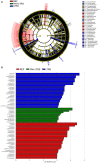Altered Lung Microbiome and Metabolome Profile in Children With Pulmonary Arterial Hypertension Associated With Congenital Heart Disease
- PMID: 35966852
- PMCID: PMC9366172
- DOI: 10.3389/fmed.2022.940784
Altered Lung Microbiome and Metabolome Profile in Children With Pulmonary Arterial Hypertension Associated With Congenital Heart Disease
Abstract
Backgrounds: Pulmonary arterial hypertension (PAH) is characterized by progressive pulmonary vascular functional and structural changes, resulting in increased pulmonary vascular resistance and eventually right heart failure and death. Congenital Left-to-Right shunts (LTRS) is one type of congenital heart disease (CHD) and PAH associated with the congenital Left-to-Right shunt (PAH-LTRS) is a severe disease in children. However, changes in the lung microbiome and their potential impact on PAH-LTRS have not been not fully studied. We hypothesized that lung microbiota and their derived metabolites have been disturbed in children with PAH-LTRS, which might contribute to the progression and outcomes of PAH-LTRS.
Methods: In this study, 68 age- and sex-matched children of three different groups (patients with PAH-LTRS cohort, patients with LTRS but have no pathologic features of PAH cohort, and healthy reference cohort) were enrolled in the current study. Bronchoalveolar lavage fluid samples from these participants were conducted for multi-omics analysis, including 16S rRNA sequencing and metabolomic profiling. Data progressing and integration analysis were performed to identify pulmonary microbial and metabolic characteristics of PAH-LTRS in children.
Results: We found that microbial community density was not significantly altered in PAH-LTRS based on α-diversity analysis. Microbial composition analysis indicated phylum of Bacteroidetes was that less abundant while Lactobacillus, Alicycliphilus, and Parapusillimonas were significantly altered and might contribute to PAH in children with LTRS. Moreover, metabolome profiling data showed that metabolites involved in Purine metabolism, Glycerophospholipid metabolism, Galactose metabolism, and Pyrimidine metabolism were also significantly disturbed in the PAH-LTRS cohort. Correlation analysis between microbes and metabolites indicated that alterations in the microbial composition from the lung microbiota could eventually result in the disturbance in certain metabolites, and might finally contribute to the pathology of PAH-LTRS.
Conclusion: Lung microbial density was not significantly altered in patients with PAH-LTRS. Composition analysis results showed that the relative microbiome abundance was different between groups. Metabolome profiling and correlation analysis with microbiota showed that metabolome also altered in children with PAH-LTRS. This study indicated that pulmonary microbes and metabolites disturbed in PAH-LTRS could be potentially effective biomarkers and provides valuable perspectives on clinical diagnosis, treatment, and prognosis of pediatric PAH-LTRS.
Keywords: congenital heart disease; left to right shunt; lung; metabolome; microbiome; pulmonary arterial hypertension.
Copyright © 2022 Ma, Cheng, Song, Sun, Gui, Deng, Xie and Liu.
Conflict of interest statement
The authors declare that the research was conducted in the absence of any commercial or financial relationships that could be construed as a potential conflict of interest.
Figures






Similar articles
-
Integrated multi-omics analysis of the microbial profile characteristics associated with pulmonary arterial hypertension in congenital heart disease.Microbiol Spectr. 2024 Oct 29;12(12):e0180824. doi: 10.1128/spectrum.01808-24. Online ahead of print. Microbiol Spectr. 2024. PMID: 39470277 Free PMC article.
-
NMR-Based Metabolomic Analysis of Plasma in Patients with Adult Congenital Heart Disease and Associated Pulmonary Arterial Hypertension: A Pilot Study.Metabolites. 2022 Sep 8;12(9):845. doi: 10.3390/metabo12090845. Metabolites. 2022. PMID: 36144249 Free PMC article.
-
Management of pulmonary arterial hypertension associated with congenital systemic-to-pulmonary shunts and Eisenmenger's syndrome.Drugs. 2008;68(8):1049-66. doi: 10.2165/00003495-200868080-00004. Drugs. 2008. PMID: 18484798 Review.
-
Pulmonary Arterial Hypertension Patients Have a Proinflammatory Gut Microbiome and Altered Circulating Microbial Metabolites.Am J Respir Crit Care Med. 2023 Mar 15;207(6):740-756. doi: 10.1164/rccm.202203-0490OC. Am J Respir Crit Care Med. 2023. PMID: 36343281 Free PMC article.
-
[Pediatric pulmonary hypertension and pulmonary arterial hypertension secondary to congenital heart diseases].Anadolu Kardiyol Derg. 2010 Aug;10 Suppl 1:50-6. doi: 10.5152/akd.2010.119. Anadolu Kardiyol Derg. 2010. PMID: 20819767 Review. Turkish.
Cited by
-
Study on the fourof Pfaffia glomerata based on the metabolomics technology and comparison of Dangshen () in the equivalent substitution prescription.J Tradit Chin Med. 2024 Aug;44(4):713-721. doi: 10.19852/j.cnki.jtcm.20240521.001. J Tradit Chin Med. 2024. PMID: 39066532 Free PMC article.
-
Genetic association and bidirectional Mendelian randomization for causality between gut microbiota and six lung diseases.Front Med (Lausanne). 2023 Dec 15;10:1279239. doi: 10.3389/fmed.2023.1279239. eCollection 2023. Front Med (Lausanne). 2023. PMID: 38162878 Free PMC article.
-
Pulmonary arterial hypertension associated with congenital heart disease: An omics study.Front Cardiovasc Med. 2023 Mar 10;10:1037357. doi: 10.3389/fcvm.2023.1037357. eCollection 2023. Front Cardiovasc Med. 2023. PMID: 36970344 Free PMC article. Review.
-
Integrated multi-omics analysis of the microbial profile characteristics associated with pulmonary arterial hypertension in congenital heart disease.Microbiol Spectr. 2024 Oct 29;12(12):e0180824. doi: 10.1128/spectrum.01808-24. Online ahead of print. Microbiol Spectr. 2024. PMID: 39470277 Free PMC article.
-
Metabolomics: A New Tool in Our Understanding of Congenital Heart Disease.Children (Basel). 2022 Nov 24;9(12):1803. doi: 10.3390/children9121803. Children (Basel). 2022. PMID: 36553246 Free PMC article. Review.
References
-
- Kovacs G, Dumitrescu D, Barner A, Greiner S, Grunig E, Hager A, et al. . Definition, clinical classification and initial diagnosis of pulmonary hypertension: updated recommendations from the Cologne Consensus Conference 2018. Int J Cardiol. (2018) 272S:11–9. 10.1016/j.ijcard.2018.08.083 - DOI - PubMed
LinkOut - more resources
Full Text Sources

